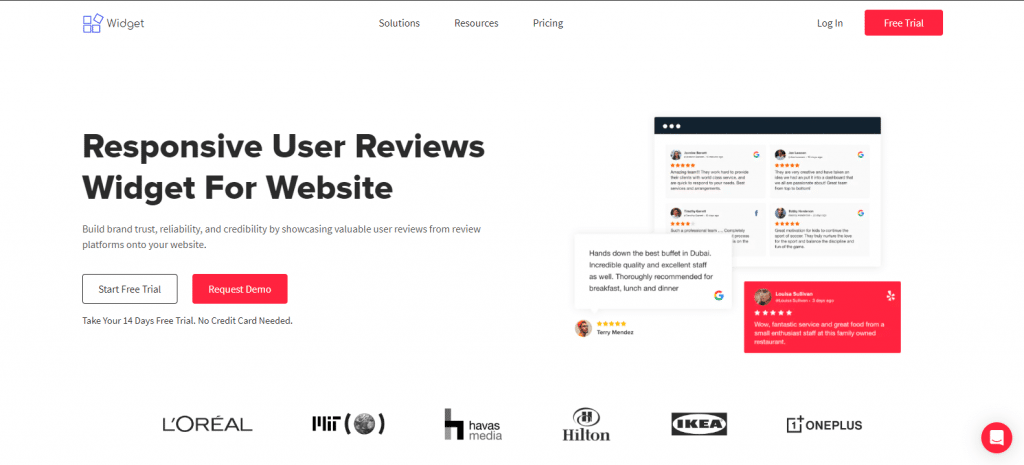Read summarized version with
A review not managed is a review not utilized to the fullest. A successful brand understands the importance of all kinds of reviews whether they’re positive or negative. It’s important to monitor, analyze, and respond to these reviews even if they are full of criticism. Review management plays a pivotal role in shaping the image of the brand in the market.
With consumers’ increasing reliance on online reviews, businesses need effective strategies and tools to manage their online reputation. When a customer sees other people saying good things about a brand, it fosters trust in their minds.
We’ll delve deeper into the world of review management, understanding the significance of online reviews. The benefits of effective review management strategies and the top review management software solutions will also be explored.

What is Online Review Management?
Online Review management refers to the process of actively monitoring, analyzing, and responding to customer reviews posted on various online platforms. The primary goal of review management is to maintain a positive online presence and address any negative feedback promptly.

80% People Read Online Reviews Before Making A Purchase!
Embed Reviews and Display On Website> Try Tagbox > It’s Free For 14 Days!
Signup, Its FREEAll PRO Features | Cancel Any Time
Whether it’s expressing gratitude for positive reviews or addressing concerns raised in negative ones, responding demonstrates a commitment to customer satisfaction. Even an average customer reads at least 7 reviews before deciding whether they want to buy a product or not. They trust a brand when they see that it has a lot of positive reviews from previous users of the product/ services.
96% of consumers specifically read the negative reviews to understand if there is a common issue faced by other people. When they see a brand promptly responding to its negative reviews and addressing the concerns it raises, it fosters trust.
Managing online reviews often involves utilizing specialized software solutions designed to streamline the review monitoring and response process. Online review management is an essential process for brands looking to maintain a positive online reputation and build trust with customers. It also helps brands drive business growth in today’s competitive digital landscape.
Advantages of Online Review Management
To understand how important review management is, it’s important to know what benefits it offers. This process has a plethora of benefits for brands aiming to enhance their online reputation and customer relationships.
Here are some key advantages that a brand can enjoy if they properly implement online review management:
1. Improved Online Reputation: Utilizing a review management platform enables businesses to actively monitor and manage their online reviews across various platforms. By promptly addressing both positive and negative feedback, businesses can maintain a good online reputation and build trust.
2. Enhanced Customer Trust: Positive reviews and timely responses to customer feedback demonstrate a commitment to customer satisfaction. This fosters trust and confidence in the brand, leading to increased customer loyalty and repeat business.
3. Increased Visibility and Credibility: Businesses with a strong online reputation are more likely to attract new customers. Positive reviews serve as social proof of the quality of products or services offered, making the business more appealing.
4. Better Understanding of Customer Needs: Tools offering review management provide valuable insights into customer sentiment and preferences. By analyzing trends in customer feedback, businesses can identify areas for improvement and make data-driven decisions.
5. Competitive Advantage: Proactively managing online reviews gives businesses a competitive edge in their industry. By showcasing positive reviews and addressing negative feedback, businesses can differentiate themselves from competitors and position themselves as industry leaders.
6. Streamlined Review Monitoring and Response: Review management services streamline the process of monitoring reviews and responding to customer feedback. Automated alerts and notifications ensure that businesses stay informed about new reviews and can respond promptly, saving time and effort.
7. Measurable Results and Insights: Platforms offering review management provide analytics and reporting tools that provide valuable insights into the performance of review management efforts. Businesses can track key metrics such as review volume and sentiment trends to measure the impact of their review management strategies.
5 Different Stages of Review Management
Now that we know the benefits review management offers, it’s crucial to understand the foundational steps involved in its implementation. Establishing a robust online presence begins with claiming business listings across relevant platforms. Once claimed, businesses can proactively request reviews from satisfied customers and ensure they respond promptly and professionally to all feedback received.
Here is a detailed explanation of the 5 stages of review management.
1. Claim Business Listings:
Claiming online business listings is the initial step in online review management. It involves verifying and updating business information on various review platforms such as Google My Business, Yelp, etc. By claiming listings, brands can ensure accuracy as well as accessibility for customers who are searching for their products/ services.

2. Requesting Customer Reviews:
Proactively soliciting reviews from satisfied customers is crucial for maintaining a robust online presence of a brand. Brands can use various channels to request reviews via email, social media platforms, or in-person interactions with customers. By encouraging feedback, businesses can generate a steady stream of reviews that reflect positively on their reputation.

3. Prompt Response:
Timely and personalized responses to reviews, both positive and negative, are essential for effective online review management. Responding to reviews shows appreciation for positive feedback and the brand’s commitment to addressing concerns raised in negative reviews. Engaging with customers demonstrates a commitment to their satisfaction and can help mitigate any potential damage to the brand’s reputation.
4. Showcasing Reviews:
Amplifying the best reviews involves showcasing them across various marketing fronts like social media, email brand websites, etc. This helps a brand maximize its impact and enhance its image in the market. Businesses can feature positive reviews on their website, social media profiles, and marketing materials. By highlighting glowing testimonials, businesses can attract new customers and reinforce their reputation. Here are a few ways how you can display your reviews for better brand recognition and reputation.

A.) Review Widgets
Implementing review widgets on the website prominently showcases positive customer feedback, including star ratings, testimonials, and customer comments. You can use social proof tools like Google Review Widget that provide visitors with valuable information, reinforcing the brand’s credibility. This ultimately fosters trust in the minds of the customers and encourages them to choose a particular product or a service.
Start Embedding Google Reviews on Your Website Now!
Signup NowB.) Embedding a Review Badge
Embedding a review badge on website adds credibility and reassurance to potential customers exploring the site. Featuring the average star rating and the total number of reviews creates a better picture for a potential customer. This visual representation of positive feedback enhances the brand’s reputation and encourages trust among visitors.
C.) Adding Testimonials in Ads
Incorporating customer testimonials into advertising campaigns, such as social media ads or email marketing, enhances the authenticity of promotional efforts. Genuine testimonials from satisfied customers serve as powerful endorsements and social proof, influencing purchasing decisions. Brands can also embed Google reviews on website to attract more customers to their products/ services.
5. Monitor and Analyze

Continuous monitoring and analysis of reviews are essential for ongoing review management success. Businesses should use review management tools to track review trends, sentiment, and key metrics. By analyzing data, brands can identify areas for improvement, measure the effectiveness of their review management strategies, and make decisions. It also helps brands understand the general perception of the people about their product or service.
Key Features of Taggbox’s Review Management Software (Embed Review Widget in Easy Steps)
Understanding and implementing all the stages above can be very complex, which is why we bring you Taggbox’s review management software. It is a comprehensive solution designed to streamline and enhance the management of online reviews.

Taggbox empowers businesses with powerful features tailored to optimize review handling and maximize customer satisfaction. Let’s delve into the key functionalities offered by Taggbox’s innovative review management platform.
Replicate Brand’s Favorite Online Reputation Management Strategy With Taggbox | Get Started Now | Look No Further
Try For Free1. Review Aggregation
Taggbox’s review management software simplifies the process of collecting customer reviews from various online platforms like Google Reviews, Yelp, etc. With its aggregation feature, brands can effortlessly showcase reviews from different sources on their social media channels or their website.
Centralizing review collection allows Taggbox to ensure that businesses have easy access to all customer feedback in one unified platform. This eventually facilitates efficient review management and analysis, resulting in better marketing strategies by the brands.

2. Managing Responses
The review management tool offered by Taggbox includes robust response management features, empowering brands to engage with customers effectively. Using this software, brands can easily monitor and respond to reviews from various platforms.

This ensures that customer feedback is addressed promptly, showcasing the brand’s commitment to customer satisfaction. By providing tools for personalized responses and sentiment analysis, Taggbox enables businesses to maintain positive relationships with customers. Brands can effectively manage their online reputation with powerful response management.
3. Analytics and Insights
Taggbox offers comprehensive reporting and analytics capabilities, providing brands with valuable insights into their online reputation. It provides detailed reports on review trends, sentiment analysis, and customer feedback.
This enables brands to track performance, identify areas for improvement, and make data-driven decisions. By leveraging advanced data analytics tools, businesses can optimize their review management strategies and enhance customer satisfaction. This eventually leads to brand growth and success because of a better online image.

4. Seamless Integration
The review management software seamlessly integrates with a variety of other platform solutions, ensuring smooth workflow integration for businesses. Whether it’s social media channels or email marketing platforms, Taggbox offers flexible integration options to suit diverse business needs.

By syncing data across platforms, Taggbox enables brands to streamline their operations and maximize the results achieved by review management. With seamless compatibility with other software, empower businesses to leverage the full potential of their digital ecosystem.
5. Customization and Personalization
This effective tool also offers extensive customization options for the dashboard, allowing brands to tailor user experience according to their preferences. From customizable layouts to personalized widgets, brands can create a dashboard that aligns perfectly with their branding and workflow.

With the ability to customize dashboards, businesses can optimize their review management process and enhance overall efficiency and effectiveness. Personalizing the review responses makes the customer feel heard and hence increases retention possibilities.
Effective Review Management Strategy (+4 Strategies)
Crafting an effective review management strategy is essential for businesses to maintain a positive online reputation and enhance customer satisfaction. Key tactics include prompt response to reviews, soliciting feedback from satisfied customers, and leveraging insights from analytics to continuously improve.
Implementing a proactive approach and prioritizing customer feedback allows brands to build trust, foster loyalty, and drive success. Following are some of the best strategies a brand must follow for efficient review management.
1. Prompt Responses
When you respond promptly and personally to customer reviews, it demonstrates attentiveness and care, fostering a positive relationship with the customer.
Taggbox’s review management software enables businesses to craft tailored responses efficiently, addressing customer concerns and inquiries with sincerity and professionalism. By prioritizing personalized communication, businesses can strengthen customer rapport, showcase their commitment to satisfaction, and cultivate a loyal customer base.
2. Encourage Customers to Review
By encouraging customers to leave reviews, brands can enhance their online reputation and garner valuable feedback. Our review management software provides tools for soliciting reviews from satisfied customers through various channels like email campaigns or in-store prompts.
Incentivizing and facilitating the review process lets a brand amplify its online presence, and attract more potential customers. This also allows brands to reinforce their credibility in the marketplace due to increased customer reviews.
3. Leverage Constructive Reviews
With Taggbox’s review management software, businesses can analyze negative feedback to identify areas for enhancement and address customer concerns effectively.
Brands can demonstrate their commitment to customer service by responding empathetically to the reviews and resolving issues promptly. Embracing criticism constructively can ultimately lead to positive outcomes and long-term success in the competitive market landscape.
4. Regular Monitoring
Regularly monitoring and managing reviews is essential for maintaining a positive online reputation and promptly addressing customer feedback. With Taggbox, businesses can stay vigilant by monitoring reviews across various platforms and promptly responding to reviews.
By actively analyzing customer reviews businesses can mitigate potential issues before they escalate, and foster trust among their audience. Consistent review management not only safeguards a brand’s reputation but also presents opportunities for improvement in this digital landscape.
Difference Between Review Management vs. Reputation Management
| Review Management | Reputation Management |
|---|---|
| Review Management focuses specifically on monitoring, analyzing, and responding to customer reviews and rating feedback across various online platforms. It involves actively soliciting reviews, managing their content, and addressing customer concerns promptly. | Reputation Management encompasses a broader scope, including not only reviews but also other mentions, social media activity, and brand perception. It involves actively shaping and influencing public perception to maintain a positive brand image. |
| It primarily deals with managing customer reviews, whether positive or negative, to improve customer satisfaction and brand reputation. It centers on the direct interactions between businesses and customers on review platforms. | It extends beyond reviews to encompass all aspects of online presence, including social media, industry news articles, etc. It focuses on shaping public perception of the brand through strategic communication and engagement. |
| The primary objective of Review Management is to monitor customer feedback, enhance customer satisfaction, and address any issues raised in reviews. It aims to build trust, credibility, and loyalty among customers. | It aims to enhance the overall reputation of the brand by managing narratives, addressing negative publicity, and promoting brand attributes. It seeks to establish a favorable perception of the brand among the target audience. |
| It focuses specifically on customer reviews, ratings, and feedback posted on review platforms, such as Google, Yelp, TripAdvisor, etc. It involves analyzing trends, responding to reviews, and leveraging feedback to improve products or services. | It takes a broader perspective, encompassing not only reviews but also social media mentions, articles, blog posts, and online forums. It involves monitoring online conversations, addressing brand-related issues, and managing public perception proactively. |
| It involves direct engagement with customers who leave reviews, responding to their feedback, addressing concerns, and acknowledging positive experiences. It emphasizes building relationships and fostering dialogue with customers. | It focuses on shaping the perception of the brand among a wider audience, including potential customers, influencers, journalists, and stakeholders. It involves strategic communication and storytelling to shape public opinion and influence brand perception. |
Are you Ready to Try the Review Widget?
Effective review management is paramount for businesses looking to thrive in the digital age. Implementing strategies such as prompt responses to reviews and soliciting feedback helps a brand enhance its online reputation.
With Taggbox, businesses gain the tools and resources needed to streamline their review management processes and achieve sustainable growth. Embracing a proactive approach to review management not only strengthens customer relationships but also positions brands for success.
Embed All-in-One Review Widget On Your Website Now!
- Yelp
- Airbnb
Take 14-Day Free Trial
Signup Now









